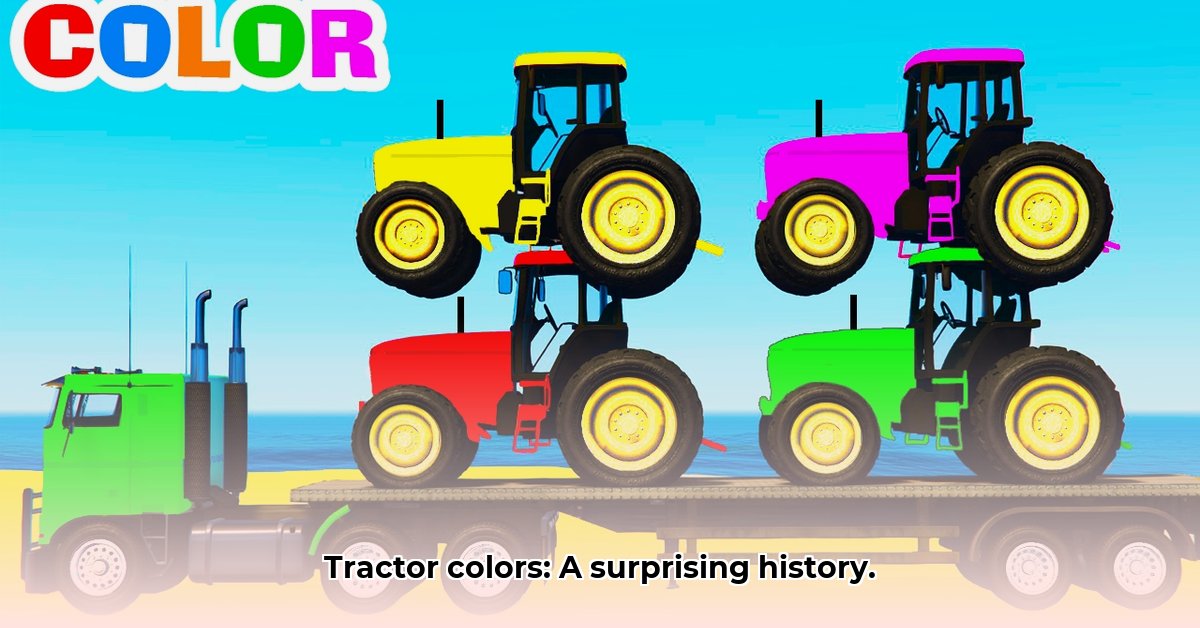
Ever wonder why some tractors are definitively green, others a fiery red, and still others a unique shade of blue? It's more than just aesthetics; it's a captivating story woven into the very fabric of agricultural history and marketing strategy. This article explores the fascinating evolution of tractor colors, revealing the ingenious marketing behind those iconic hues and examining their enduring impact on brands and farmers alike. From the humble beginnings of practicality to the sophisticated psychology of color choice, we will uncover the surprising power of paint on the fields and in the boardrooms. For specific paint information, check out this helpful resource on Ford tractor paint.
The Early Days: A Palette of Practicality
Imagine a time before flawlessly matched paint jobs. Early 20th-century tractor manufacturers often relied on readily available and affordable paints. Durability was paramount; the color had to withstand relentless sun, torrential rain, and caked-on mud. Earthy tones and muted shades dominated—a stark contrast to the vibrant greens and reds that would later define iconic brands. These early choices, dictated by necessity, unexpectedly laid the foundation for the powerful visual identities we know today. Did the lack of vibrant colors hinder sales? While early marketing was less sophisticated, the focus remained primarily on functionality, rather than the aesthetic appeal of the machinery.
John Deere's Green: From Humble Beginnings to Global Icon
John Deere's iconic green isn't the vibrant shade we instantly recognize today. Its evolution mirrors the company's journey from a small blacksmith shop to a global behemoth. Early John Deere machines sported a more subdued green, perhaps closer to olive or a muted yellowish-green. Over time, the shade was refined, gaining boldness and richness, eventually achieving the trademark hue that instantly evokes John Deere worldwide. This gradual refinement reflects advancements in paint technology and, crucially, the company's growing market dominance. Why this specific shade? While the exact reasons remain somewhat obscure, its association with the vibrancy of nature and the enduring strength of the land likely played a role in its lasting appeal.
The Red Revolution: Challenging the Green Goliath
While John Deere solidified its green reign, competitors staked their claims with equally powerful colors. International Harvester, for example, made its mark with a bold, vibrant crimson red. This wasn't merely a color choice; it was a strategic decision to differentiate itself in a crowded market. The red tractors, powerful and attention-grabbing, carved their own legacy into the agricultural landscape, creating a compelling visual rivalry with the established John Deere green. Was the red a symbol of power and energy, consciously contrasting with Deere's more understated green? Marketing materials from the era suggest a conscious effort to convey a sense of strength and dynamism.
The Psychology of Hues: More Than Just Looks
The choice of tractor color is a fascinating study in marketing psychology. Red often implies energy, power, and even aggression, while green suggests tranquility, nature, and reliability. These subconscious associations aren't accidental. Marketing experts understand the potent effect of color on emotions and purchasing decisions. A substantial investment like a new tractor often leans on brand familiarity and color psychology. Color transcends the purchase of machinery; it represents a connection to brand history and legacy.
Beyond Marketing: Practicality Persists
While brand identity is paramount, the practicality of color choice cannot be dismissed. Early paints lacked the durability of modern equivalents. Some colors offered better resistance to fading, chipping, and general wear and tear in demanding conditions. The evolution of paint technology allowed manufacturers to create richer, more resilient colors, enhancing both visual appeal and machine longevity. Even with advancements, core brand colors remained largely consistent, highlighting the importance of consistent brand identity. How did manufacturers determine the balance? There is evidence that extensive testing was undertaken to ensure that the colors chosen not only looked good but also could withstand the rigors of agricultural use.
A Legacy in Chrome and Steel: Preserving History
The enduring loyalty of farmers and collectors to original tractor colors is telling. Many vintage tractor enthusiasts meticulously restore machines to their original paint schemes, accurately matching the shade and finish. This isn't merely aesthetics; it’s preserving a piece of history. These restored machines, resplendent in their original colors, offer a tangible connection to a bygone era, reflecting a time with vastly different farming practices and technology. Their paint schemes are an integral part of their narrative. Why this passion for original colors? For many collectors, it’s about preserving authenticity and connecting with a tangible piece of agricultural heritage.
The Future of Tractor Colors: A New Generation of Hues?
Today, tractor colors remain powerful brand identifiers. However, the industry is constantly evolving. Manufacturers experiment with digital color experiences, using augmented reality to showcase color options and offering increasingly customized choices. Some experts predict a revival of less common colors as manufacturers seek to personalize their offerings. Will this lead to more individualized branding or a departure from established color harmonies? The future of tractor colors represents a fascinating blend of tradition and innovation.
The Impact of Color on Key Stakeholders
| Stakeholder | Impact of Tractor Color |
|---|---|
| Tractor Collectors | Original paint is highly valued; original color significantly impacts a tractor's worth |
| Museums | Accurate original paint is crucial for historical accuracy; Maintaining original colors is essential for authenticity |
| Restoration Specialists | Expert knowledge of color variations across production years is paramount for accurate restoration |
This table emphasizes how tractor color extends beyond marketing value. Preserving original paint schemes is crucial for historical accuracy and reinforces the machines' importance as heritage objects. The color itself plays a significant role in preserving agricultural heritage.